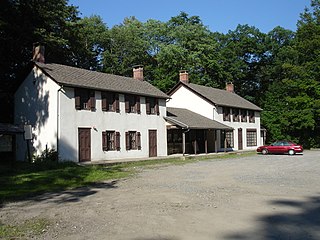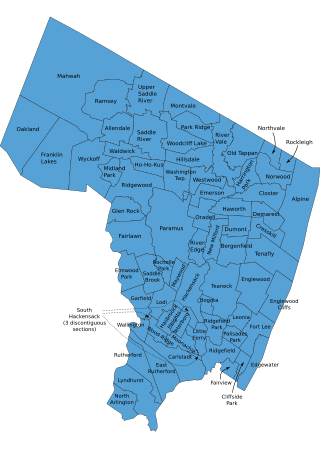
Lake Como is a borough located in the Jersey Shore region, within Monmouth County, in the U.S. state of New Jersey. As of the 2020 United States census, the borough's population was 1,697, a decrease of 62 (−3.5%) from the 2010 census count of 1,759, which in turn reflected a decline of 47 (−2.6%) from the 1,806 counted in the 2000 census. It is the tenth-smallest municipality by land area in New Jersey.

Berkeley Township is a township in Ocean County, in the U.S. state of New Jersey, extending from the Jersey Shore westward into the New Jersey Pine Barrens. As of the 2020 United States census, the township's population was 43,754, the highest ever in any decennial count and an increase of 2,499 (+6.1%) from the 2010 census count of 41,255, which in turn reflected an increase of 1,264 (+3.2%) from the 39,991 counted in the 2000 census.

West Milford is a township in Passaic County, in the U.S. state of New Jersey. As of the 2020 United States census, the township's population was 24,862, a decrease of 988 (−3.8%) from the 2010 census count of 25,850, which in turn reflected a decline of 560 (−2.1%) from the 26,410 counted in the 2000 census. It is the largest in the county by total area, covering 80.32 square miles (208.0 km2) and more than 40% of the county.

North Plainfield is a borough in Somerset County, in the U.S. state of New Jersey. It is located within the Raritan Valley region. As of the 2020 United States census, the borough's population was 22,808, an increase of 872 (+4.0%) from the 2010 census count of 21,936, which in turn reflected an increase of 833 (+3.9%) from the 21,103 counted in the 2000 census.

Watchung is a borough in Somerset County, in the U.S. state of New Jersey, located approximately 29 miles (47 km) west of New York City. As of the 2020 United States census, the borough's population was 6,449, an increase of 648 (+11.2%) from the 2010 census count of 5,801, which in turn reflected an increase of 188 (+3.3%) from the 5,613 counted in the 2000 census. It is located within the Raritan Valley region.

Roselle is a borough located in Union County in the U.S. state of New Jersey. As of the 2020 United States census, the borough's population was 22,695, an increase of 1,610 (+7.6%) from the 2010 census count of 21,085, which in turn reflected a decline of 189 (−0.9%) from the 21,274 counted in the 2000 census.

Roselle Park is a borough in Union County, in the U.S. state of New Jersey. As of the 2020 United States census, the borough's population was 13,967, an increase of 670 (+5.0%) from the 2010 census count of 13,297, which in turn reflected reflected an increase of 16 (+0.1%) from the 13,281 counted in the 2000 census.
A township, in the context of New Jersey local government, refers to one of five types and one of eleven forms of municipal government. As a political entity, a township in New Jersey is a full-fledged municipality, on par with any town, city, borough, or village. They collect property taxes and provide services such as maintaining roads, garbage collection, water, sewer, schools, police and fire protection. The Township form of local government is used by 27% of New Jersey municipalities; however, slightly over 50% of the state's population resides within them.
The Optional Municipal Charter Law or Faulkner Act provides New Jersey municipalities with a variety of models of local government. This legislation is called the Faulkner Act in honor of the late Bayard H. Faulkner, former mayor of Montclair, New Jersey and chairman of the Commission on Municipal Government.
A city in the context of local government in New Jersey refers to one of five types and one of eleven forms of municipal government. Despite the widely held perception of a city as a large, urban area, cities in New Jersey have a confused history as a form of government and vary in size from large, densely populated areas to much smaller hamlets.

Boroughitis was the creation in the 1890s, usually by referendum, of large numbers of small boroughs in the U.S. state of New Jersey, particularly in Bergen County. Attempts by the New Jersey Legislature to reform local government and school systems led to the breakup of most of Bergen County's townships into small boroughs, which still balkanize the state's political map. This occurred following the development of commuter suburbs in New Jersey, residents of which wanted more government services, whereas the long-time rural population feared the increases in taxation that would result.
A special charter allows a New Jersey municipality to operate under a charter that differs from those of the traditional forms of government or the many options available under the Faulkner Act. Under the terms of the New Jersey State Constitution of 1947 and the Faulkner Act of 1950, a municipality may obtain a special charter form from the New Jersey Legislature, providing a unique form of governmental organization for that community.

The members of the New Jersey Legislature are chosen from 40 electoral districts. Each district elects one senator and two assemblymen.

The members of the New Jersey Legislature are chosen from 40 electoral districts. Each district elects one senator and two assemblymen.

The members of the New Jersey Legislature are chosen from 40 electoral districts. Each district elects one senator and two assemblymen.









